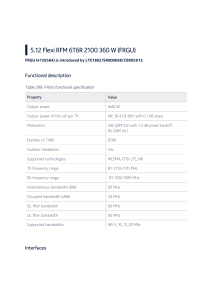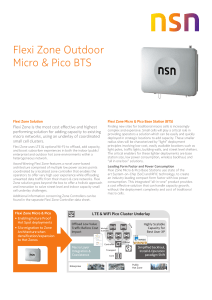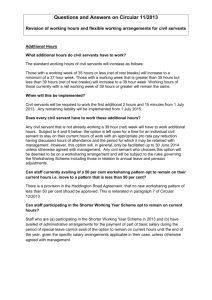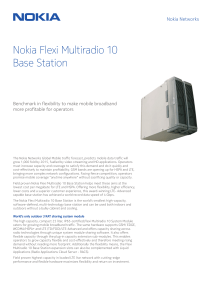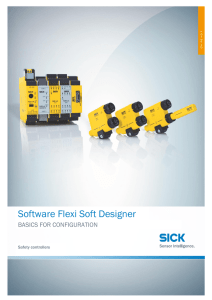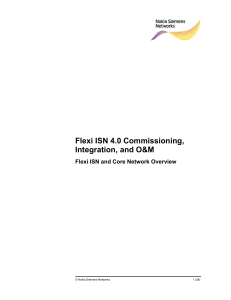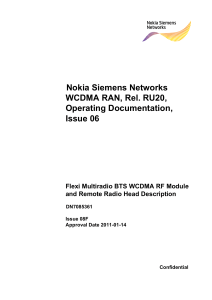Some of the more common flexible working arrangements Types of flexibility
advertisement
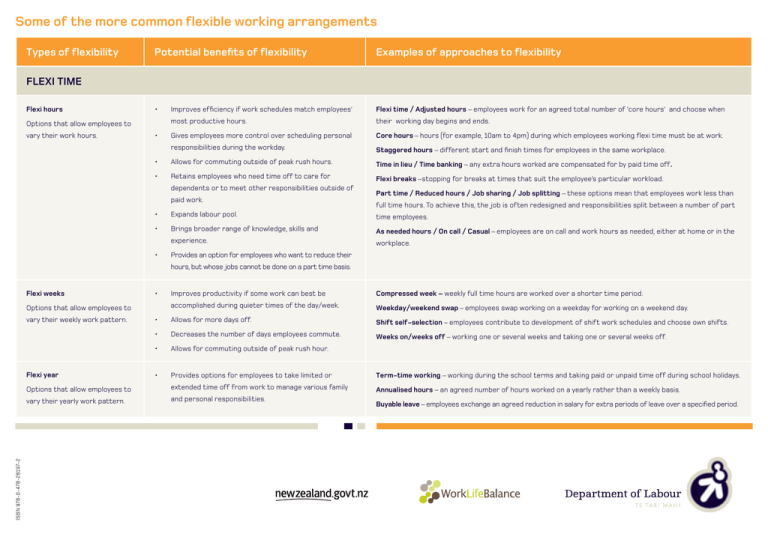
Some of the more common flexible working arrangements Types of flexibility Potential benefits of flexibility Examples of approaches to flexibility • Improves efficiency if work schedules match employees’ Flexi time / Adjusted hours – employees work for an agreed total number of ‘core hours’ and choose when most productive hours. their working day begins and ends. Gives employees more control over scheduling personal Core hours – hours (for example, 10am to 4pm) during which employees working flexi time must be at work. responsibilities during the workday. Staggered hours – different start and finish times for employees in the same workplace. • Allows for commuting outside of peak rush hours. Time in lieu / Time banking – any extra hours worked are compensated for by paid time off. • Retains employees who need time off to care for Flexi breaks –stopping for breaks at times that suit the employee’s particular workload. FLEXI TIME Flexi hours Options that allow employees to vary their work hours. • dependents or to meet other responsibilities outside of paid work. Part time / Reduced hours / Job sharing / Job splitting – these options mean that employees work less than full time hours. To achieve this, the job is often redesigned and responsibilities split between a number of part • Expands labour pool. time employees. • Brings broader range of knowledge, skills and As needed hours / On call / Casual – employees are on call and work hours as needed, either at home or in the experience. workplace. • Provides an option for employees who want to reduce their hours, but whose jobs cannot be done on a part time basis. Flexi weeks Improves productivity if some work can best be Compressed week – weekly full time hours are worked over a shorter time period. accomplished during quieter times of the day/week. Weekday/weekend swap – employees swap working on a weekday for working on a weekend day. • Allows for more days off. Shift self-selection – employees contribute to development of shift work schedules and choose own shifts. • Decreases the number of days employees commute. Weeks on/weeks off – working one or several weeks and taking one or several weeks off. • Allows for commuting outside of peak rush hour. • Provides options for employees to take limited or Term-time working – working during the school terms and taking paid or unpaid time off during school holidays. Options that allow employees to extended time off from work to manage various family Annualised hours – an agreed number of hours worked on a yearly rather than a weekly basis. vary their yearly work pattern. and personal responsibilities. • Options that allow employees to vary their weekly work pattern. ISBN 978-0-478-28197-2 Flexi year Buyable leave – employees exchange an agreed reduction in salary for extra periods of leave over a specified period. Types of flexibility Potential benefits of flexibility Examples of approaches to flexibility Flexi location • Offers alternative to relocation. Tele-working / Tele-commuting / Home-working / Remote-working – all these options involve working from Options that allow employees to • Expands labour pool geographically. home or another location outside of the workplace on either a full or part time basis. work from locations other than • Reduces office space and associated costs. • Accommodates employees with disabilities. • Reduces or eliminates commuting. • Provides an environment with fewer workplace FLEXI PLACE their designated workplace. distractions. Flexi worksite • Allows employees to work during their “personal best time”. • Encourages collaboration across work-groups and project teams. Options that allow employees to work from different locations Hot desking – temporary use of a workstation. • Reduces permanent office space and associated costs. Flexi career • Expands labour pool. Career break / Sabbatical – extended periods of leave that are normally unpaid. Options that allow employees • Provides options for gradual return to work after Work transition – provides opportunities for employees to make changes in their work hours, location, or job parental or other leave. responsibilities. For example, moving to a less demanding job when approaching retirement. • Allows gradual entry into retirement. Phased retirement – hours of work are progressively reduced until full retirement is reached at a specified date. • Provides opportunities for cross-training and skill Phased return / Gradual return – hours of work are progressively increased until a final schedule of full or part enhancement. time hours is reached at a specified date. Often used by parents returning from parental leave. within the workplace. FLEXI CAREER to move in and out of the workforce and structure their career around other interests/ responsibilities. Self managed work – employees work in their own way, often without direct supervision, towards an agreed goal. Job rotation / Role rotation – employees move between two or more jobs so they can cross-train and develop ISBN 978-0-478-28197-2 a wider variety of skills. PLA 10616 Some of the more common flexible working arrangements
